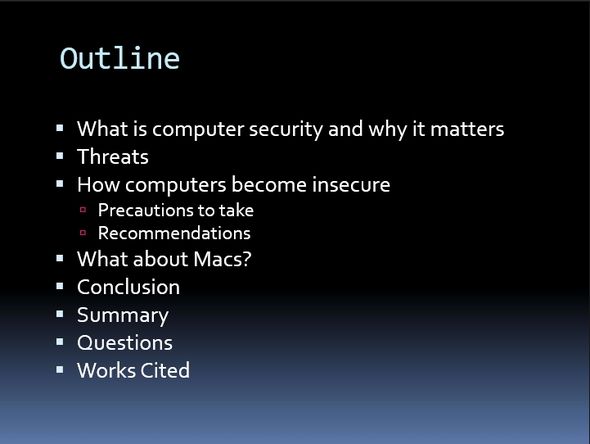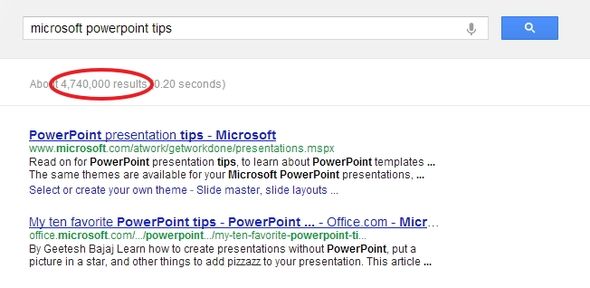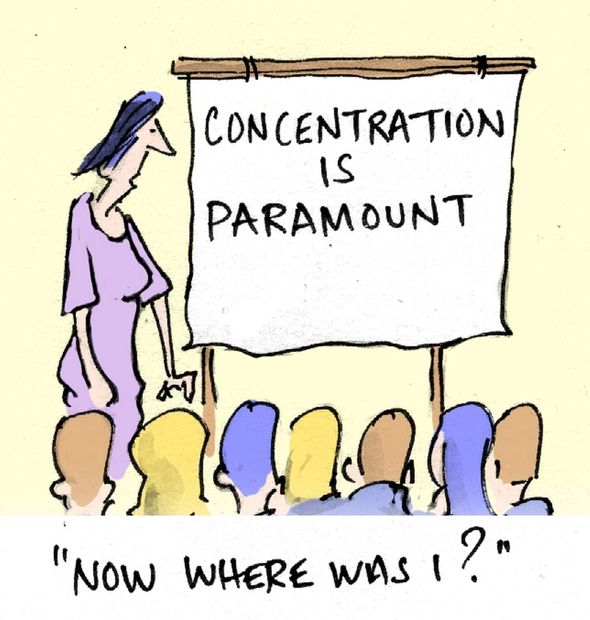Have you ever done a PowerPoint presentation? Of course you have. If you said “no,” I’d call you a liar. Alright, that may be extreme. But most of us have, right? I’d say so. So, what’s my point? My point is that here most of us have created a PowerPoint and done a presentation (or will at some point) and yet it is likely to be one of the most poorly done things on a computer.
The presentations I saw done in college, both by students and the instructors, were embarrassing, to say the least. From ridiculously long slides by instructors to students who looked like they didn’t know how to read (which they shouldn’t have been doing in the first place). Bad PowerPoint presentations is an epidemic in education, which then continues into the workplace. Of course it’s not only about the PowerPoint itself, but also the presenter and how well they speak and convey the information. And I will touch upon that as well.
Begin With An Outline
Just like when writing a report, it is helpful to have specific points laid out. Usually this is just for you to get your thoughts down. In a PowerPoint though, it is nice for your audience to see what the presentation they’re about to sit through will go over. It connects them a little bit more and keeps them interested, especially if there was something in the timeline that intrigued them. The outline is simple and only consists of the exact things you intend to cover. Sometimes it’s ok to get a little more detailed and extend the outline to give more information about sub-topics that will be covered. This, however, depends on the thoroughness of your presentation and the requirements of the specific content that you are covering. Below is an example of an outline in a presentation I did on computer security.
Be Consistent With The Theme And Layout
There are several aspects of keeping distractions to a minimum and being consistent with your theme and layout throughout your PowerPoint is certainly a major player in that. You don’t want to create any thoughts that would alter the audience’s focus on your content and what your are saying. You can do this by not only keeping the theme consistent (that is pretty straightforward), but also the layout. For example, if one topic takes up two slides, be sure to label the second slide and add “(Continued)” at the end of the title. This will quickly show the audience you’re on the same topic, despite switching slides and keep the focus on the topic instead of wondering what that slide might be about.
Forget Clip Art, Crazy Sounds And Fancy Transitions
Speaking of distractions, this is another big player. Some visuals can be good. However, irrelevant visuals or sounds (actually just any sounds) and crazy transitions are not only very distracting to the audience, but also it gives your PowerPoint a less professional appears. I would recommend staying away from most of these, such as this green-ish-yellow, fluffy thing below.
In college I had an instructor who loved all of these things. I feel she should have taught/be teaching Kindergarten, if that gives you any idea what she (and her presentations) were like.
Don't Read Your PowerPoint. Period.
Really? You still read your PowerPoints? I really hope you don’t. And not to offend you if you do, but you need to stop – for the good of mankind. Alright, now that I am done taunting your dignity, let me ask you this: have you ever listened to someone read something? If they are really good at it, like some professions require, you can barely tell. But if they are average like most of us, it sounds monotone and bland. You don’t want others to think that about you right? This gets back to why you are giving the presentation in the first place. Are you giving it because you have to? Because you enjoy the topic? Or because you want the audience to absorb as much knowledge and content as possible to make positive changes? Perhaps it’s several, but hopefully the last one is one of them because, if not, you are unlikely to convey the content you worked so hard to research and assemble in a manner that your audience would enjoy learning about and applying.
Lastly, there’s no reason to read what your audience can clearly see. Your goal as a presenter is to expand beyond the PowerPoint itself. The PowerPoint is simply a guide and extensive outline for the audience to follow along throughout your presentation.
Delivery of the content is just as important as the content itself. Here’s a solution I have found for this problem, which works great for me. After creating your PowerPoint, go through it and create a script. The script can consist of anything you want from an outline or summary of your presentation to a complete imitation of what you intend to say. Throughout the script include where slide transitions will occur so you won’t forget to change slides as you are giving your presentation. It’s okay to glance down to read, but you should already have somewhat of an understanding of what you are going to say already.
Get To The Point And Assassinate The Saga
This is the other side to not reading what you are going to say. It’s hard to provide a meaningful presentation whenever all you do is read point after point (that is what the script is for). But don’t put that script in the slides themselves. That might sound like common sense to you, but I had an instructor whose slides were so packed full, it took way to long to get the major points and important information from them. Quite frustrating when trying to study. But it’s not just about studying – how about in a work place when your PowerPoint needs to be a resource to others? They don’t want to take the time to scour through your novel-like slides. So, like the title says, get to the point – it’s called a PowerPoint for a reason, not a “PowerSaga.”
Use Media, But Quality Media
Earlier I talked about not using crazy images, such as Clip Art, or other distracting media. This doesn’t mean you can’t use it at all. Photos, videos, even audio clips have their place when relevant. Key word there. Don’t have a random photo just to fill space. Instead, find something that relates to what your talking about. It’s a plus if it adds quality to what you’re already saying, however if it’s only to make the slide a little less of a sterile appearance, that is ok too. Just be sure that it is relevant to what you’re covering and won’t take away from the audience’s focus.
Use The Resources Available To You
Perhaps there’s been times where you had an idea for something you wanted to do, but didn’t have the know-how to implement it in your PowerPoint. Don’t forget about simply searching the internet. Of course there’s a lot of tips and information on the Microsoft website and it is a great resource for things such as this. But even a quick search on your preferred search engine will yield fantastic results because likely there’ has been someone else who has wondered the same thing and found a solution.
It All Lies On You, The Presenter
Capturing the audience’s attention from the get-go is crucial to the success of your presentation and the impact that it will have on them. Start with a catchy line, an intriguing statistic or a question to spark their curiosity. Once you have it, you have got to maintain it. You do this by following the previous tips mentioned here and one other thing: the vibe you give off. Are you nervous? Or are you relaxed and yourself? You need to be the latter, whatever it might be. Don’t worry if you feel your personality is inadequate for the content you’re presenting – don’t try to change it. Instead, trust your instincts and be yourself. For example, if you’re funny, throw your own humor in here and there. Or if you’re more serious, do that instead. The key is to convey confidence in yourself, your work and the content you’re presenting.
Practice. Practice. Practice. (And Don't Put It Off)
So how can you be confident in those things? Simple – practice. You should have your entire presentation (not your PowerPoint) memorized. Doing this will improve the flow of information, portray confidence, prevent dry presentations (monotone) and reading of the slides, and capture the attention of the audience better. Putting this off will only increase the negatives and decrease the positives. So don’t procrastinate and stay ahead of the game.
Backup (Because Your “Daddy Taught You Good”)
Doh! You just saved your PowerPoint in only one place – the only flash drive you had. And on the way into the building, you dropped it in a mud puddle. Hope it still works – your job/grade and other people are relying on you. If that hasn’t ever happened to you, we all know of someone who it has happened to. It’s common sense to backup, so do it! It’s free (mostly) and there is really no reason not to, except for your own laziness – which is just pathetic that you allow it to get in the way. You know you’d regret those times you didn’t backup if something like this did happen to you, so why not prevent all of that stress and just do things right from the start.
There are several ways to go about this. First, have multiple locations of the same file in different sources. So if you have the file on your computer, have it on a flash drive too. If you intend on only bringing a flash drive to plug into a different computer to give the presentation, try using a cloud service such as Dropbox, SugarSync, SkyDrive or Google Drive. There are a plethora of other services as well, but those are my preferred choices, SugarSync being my personal favorite. Another option is to have both a portable hard drive and a flash drive (or two of the same type of device), that way if you aren’t sure about the reliability of an Internet connection, you still have a backup. I’m not picky about how you backup, just as long as you do and it’s reliable.
In addition, save as you type your PowerPoint and presentation script. Name the files from the start and then simply use “Ctrl+S” as you type. I cannot count the amount of times I’ve done that in this article alone. Even if you think of saving midsentence – just do it. It only takes a second and saves hours of frustration.
Conclusion
To recap, remember that there are many things you can do to make your PowerPoint more enjoyable to read and simply understand. That said, the other 50% of the weight is determined by how well you present the material. Both must be in unison to capture and retain the audience’s attention to ensure they fully comprehend the content you have worked so hard to prepare. But it doesn’t stop there. You must focus the content to the audience’s needs and interests. If it isn’t their particular interest, you can make up for it through the areas of presenting the content itself by using analogies to relate it to them as much as possible and your own personality. Those things combined with the confidence you gained through repetitively studying your presentation script will ensure your audience stays intrigued. Lastly, don’t forget about backing up. It can seem like a hassle, but just remember it is a whole lot more of one when you must recreate everything that you lost.
For more helpful tips, check out 10 PowerPoint Tips for Preparing a Professional Presentation by Tina and The 10-20-30 Rule of PowerPoint by Guy Kawasaki.
Image Credit: Hand Breaks Through White via Shutterstock | Yellow Toy via Shutterstock | Cute Furry FerretConcentration Comic via Shutterstock [Broken URL Removed] | Illustration of businessman via Shutterstock






